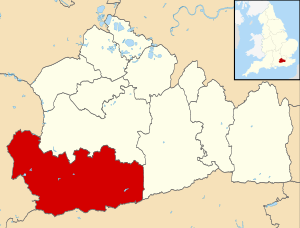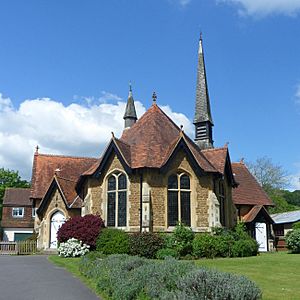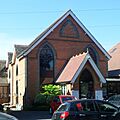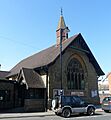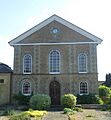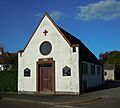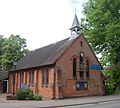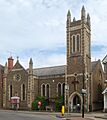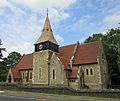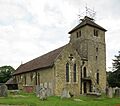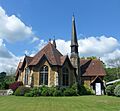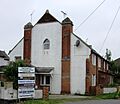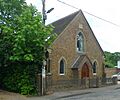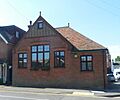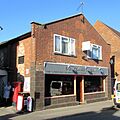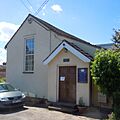List of places of worship in Waverley (borough) facts for kids
I have rewritten the wiki text for children aged 12-15, focusing on clarity, age-appropriate language, and adherence to all MediaWiki formatting rules. I have condensed the long tables of churches by selecting a few interesting examples and moved the images from the removed entries to the `==Images for kids==
Here is the rewritten text:
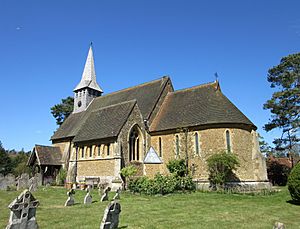
Waverley is a large area in Surrey, England, located south of London. It's mostly countryside with small towns and many villages. This area is home to over 110 places of worship, both old and new. Most of these are churches used by different Christian groups. Some old buildings that used to be churches are now used for other things.
In 2011, a survey showed that most people in Waverley were Christian. The Church of England has the most churches here. But there are also many Roman Catholic and Protestant churches. Some of these, like the Congregationalist churches, have been around since the 1600s. Other groups like Unitarians, Quakers, Methodists, and Baptists also have a long history in the area. You can also find churches for Christian Scientists, Jehovah's Witnesses, the Assemblies of God, and the Plymouth Brethren Christian Church.
Many of these religious buildings are considered "listed buildings" by Historic England. This means they are special because of their history or design. There are three levels of listing: Grade I (most important), Grade II* (very important), and Grade II (special interest). In Waverley, 38 current churches and 7 former ones have this special status.
Contents
Waverley's Churches: A Look Back
Waverley is Surrey's biggest district, covering about 133 square miles. In 2013, about 122,400 people lived here. Most of the land is farms or forests. The main towns are Farnham, Godalming, and Haslemere, plus the growing village of Cranleigh.
The area has a long history, even before the Saxons. Some churches, like those in Thursley and Witley, still have parts from the Saxon period. After the Norman conquest of England, church building changed a lot. While Waverley doesn't have any complete Norman churches, you can see Norman parts in Witley and Ewhurst. For example, the fonts (bowls for baptisms) in Alfold and Thursley are from the Norman era.
Later, in the 1200s, the Early English Gothic style became popular. Many churches in Waverley show this style. Godalming's church has beautiful windows and a tall lead spire from this time. Dunsfold's church is one of only two complete 13th-century churches in all of Surrey! In the 1300s, the more detailed Decorated Gothic style appeared, and Cranleigh's church is a great example.
The 1800s brought a big change. Many old churches were falling apart. During the Victorian era, many churches were fixed up or "restored" by famous architects. New churches were also built as towns and villages grew. Architects like William Butterfield, Benjamin Ferrey, and Henry Woodyer designed many of these new or restored churches.
Different Christian Groups in Waverley
Many Protestant groups, called Nonconformists, were strong in areas like Farnham and Godalming. However, Methodists found it hard to start churches in Surrey until the 1900s.
On the other hand, the Surrey Mission, started in 1797, helped many Congregational, Baptist, and Independent groups. They built many chapels and schools. Congregational churches were especially important. For example, Godalming's Congregational Church helped set up smaller chapels in nearby villages. Baptists also grew, building new churches in the late 1800s and 1900s.
Roman Catholicism arrived later in Waverley. At the end of the 1800s, a generous person helped build St Edmund King and Martyr's Church in Godalming and the first St Joan of Arc's Church in Farnham. Before this, local Catholics had to travel far to attend Mass.
Building Materials
Many old churches in Surrey are made of flint, but in Waverley, stone was more common. This is because of the local geology. The southern part of Waverley has a type of stone called Bargate stone, which was great for building. Churches like Alfold, Bramley, and Dunsfold were built with it. Even in the 19th and 20th centuries, new churches like Busbridge and Grayswood used Bargate stone.
Some churches also used carrstone or chalk. Many old Surrey churches have wooden towers or bell-cots, but in Waverley, only Dunsfold has one. However, medieval wooden porches are more common, seen in churches like Alfold and Elstead. Most Nonconformist chapels, from the 1700s to the late 1800s, were built with brick.
Religious Beliefs in Waverley
In 2011, a survey showed that out of 121,572 people in Waverley:
- 65.2% said they were Christian. This is higher than the average for England.
- 0.6% were Muslim.
- 0.3% were Hindu.
- 0.4% were Buddhist.
- 0.2% were Jewish.
- 0.1% were Sikh.
- 0.4% followed another religion.
- 25.3% said they had no religion.
- 7.6% did not state their religion.
How Churches are Organized
Anglican Churches
All the Anglican churches in Waverley are part of the Diocese of Guildford. This diocese is led by the Guildford Cathedral. Churches are grouped into "deaneries" for easier management. In Waverley, churches belong to the Cranleigh, Farnham, or Godalming deaneries.
Roman Catholic Churches
All Roman Catholic churches in Waverley are part of the Guildford Deanery. This deanery is one of 13 in the Roman Catholic Diocese of Arundel and Brighton. The main church for this diocese is Arundel Cathedral in West Sussex. Waverley's Catholic churches are in Farnham, Heath End, Haslemere, Hindhead, Chiddingfold, Bramley, Cranleigh, Godalming, and Milford.
Other Denominations
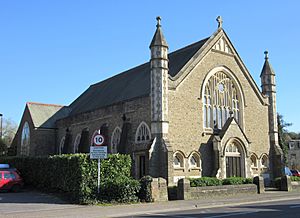
Methodist churches in Waverley are part of different "circuits." For example, Cranleigh Methodist Church and Godalming United Church are in the Guildford Methodist Circuit. Godalming United Church is also part of the Wessex Synod of the United Reformed Church, as are other United Reformed churches in the area.
Baptist churches in Waverley are part of the Guildford Network of the South Eastern Baptist Association. Some Evangelical churches in the area are part of groups like the Fellowship of Independent Evangelical Churches (FIEC) and Affinity.
Listed Buildings: What They Mean
| Grade | Criteria |
|---|---|
| Grade I | Buildings that are super special and important, sometimes even known around the world. |
| Grade II* | Buildings that are very important and have more than just special interest. |
| Grade II | Buildings that are important to the country and have special interest. |
Some Current Places of Worship
| Name | Image | Location | Denomination/ Affiliation |
Grade | Notes | Refs |
|---|---|---|---|---|---|---|
| St Nicholas' Church (More images) |
 |
Alfold 51°05′45″N 0°31′13″W / 51.095714°N 0.520247°W |
Anglican | I | This church is very old, with parts from the 1100s. It has a large roof made of Horsham Stone and uses local materials like Bargate stone. You can still see a wooden porch from the 1300s. Inside, there's an ancient Norman font. | |
| St Martin's Church (More images) |
 |
Blackheath Village 51°12′21″N 0°31′31″W / 51.205757°N 0.525255°W |
Anglican | II | This unique church was designed in 1893–95 by Charles Harrison Townsend. It looks a bit like a Spanish or Italian church. Inside, you'll find ceiling paintings and marble. | |
| St John the Baptist's Church (More images) |
 |
Busbridge 51°10′37″N 0°36′05″W / 51.177072°N 0.601507°W |
Anglican | II* | Built in 1865–67, this church has beautiful stained glass windows designed by Morris & Co.. It also features a special iron screen designed by Edwin Lutyens. | |
| St Mary's Church (More images) |
 |
Chiddingfold 51°06′35″N 0°37′48″W / 51.109821°N 0.630037°W |
Anglican | I | Only the chancel (the area around the altar) remains from the 1200s. The church is made of Bargate stone and stands on high ground in the village. | |
| St Nicholas' Church (More images) |
 |
Cranleigh 51°08′30″N 0°29′11″W / 51.141718°N 0.486340°W |
Anglican | II* | This church, mostly from the 1100s, uses many types of stone. Its tall, strong tower was built in the 1300s. | |
| St Mary and All Saints Church (More images) |
 |
Dunsfold 51°07′04″N 0°34′30″W / 51.117717°N 0.575110°W |
Anglican | I | This large church was built in the 1270s and hasn't changed much since. It's made mostly of Bargate stone and has a wooden bell-cot instead of a tower. | |
| St Andrew's Church (More images) |
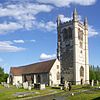 |
Farnham 51°12′47″N 0°48′03″W / 51.213185°N 0.80071°W |
Anglican | I | This big church in the town center has a huge tower. Parts of an even older Saxon church were found here. It has been rebuilt and restored many times over the centuries. | |
| The Spire Church (Farnham United Reformed Church) (More images) |
 |
Farnham 51°12′52″N 0°47′47″W / 51.214456°N 0.796525°W |
Methodist and United Reformed Church | II | This church was built in 1872–73. It's a Gothic Revival building with a tall spire. It now shares its space with the Methodist church. | |
| St Peter and St Paul's Church (More images) |
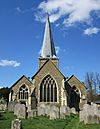 |
Godalming 51°11′13″N 0°36′58″W / 51.187047°N 0.616144°W |
Anglican | I | This church in Godalming town center has parts from many different periods, including some from before the Normans arrived! It has a unique lead-covered spire. | |
| Friends Meeting House (More images) |
 |
Godalming 51°11′07″N 0°37′04″W / 51.185303°N 0.617744°W |
Quaker | II | This Quaker meeting house was built in 1748. It's a simple brick building and has been used for worship ever since, except for a 60-year break. | |
| St Edmund King and Martyr's Church (More images) |
 |
Godalming 51°11′01″N 0°36′55″W / 51.183728°N 0.615395°W |
Roman Catholic | II | Built in 1905–06, this Catholic church stands high on a hill. It's a Gothic Revival building made of Bargate stone. | |
| Meadrow Unitarian Chapel (More images) |
 |
Godalming 51°11′37″N 0°35′52″W / 51.193522°N 0.597792°W |
Unitarian | II | This chapel was built in 1789. It's a plain brick building with arched windows and has been a Unitarian church since the early 1800s. | |
| St Peter's Church (More images) |
 |
Hascombe 51°08′47″N 0°34′09″W / 51.146385°N 0.569180°W |
Anglican | II* | This church, built in 1864, is considered one of Surrey's best Victorian churches. It's made of Bargate stone and has kept its original interior decorations. | |
| St Mark's Church (More images) |
 |
Upper Hale 51°14′05″N 0°48′01″W / 51.234795°N 0.800299°W |
Anglican | II | Built in 1883, this church uses local flints. It has beautiful and unique murals (wall paintings) in the chancel, painted by local artist Kitty Milroy. | |
| All Saints Church (More images) |
 |
Witley 51°08′55″N 0°38′52″W / 51.148727°N 0.647909°W |
Anglican | I | This large church has parts from the 1000s to the 1800s, including some Saxon work. You can still see fragments of 12th-century wall paintings inside. | |
| St John the Baptist's Church (More images) |
 |
Wonersh 51°11′46″N 0°32′57″W / 51.196102°N 0.549279°W |
Anglican | II* | This church was rebuilt in 1793 after a fire. It has an unusual tower placed halfway along its north side. |
Some Former Places of Worship
| Name | Image | Location | Denomination/ Affiliation |
Grade | Notes | Refs |
|---|---|---|---|---|---|---|
| St James's Church (More images) |
 |
Farnham 51°13′06″N 0°47′33″W / 51.218369°N 0.792539°W |
Anglican | II | This church was built in 1876 to serve the growing population of Farnham. It was later sold and converted into 16 flats in the 1980s. | |
| Park Lane Chapel (More images) |
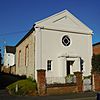 |
Farnham 51°13′00″N 0°47′55″W / 51.216585°N 0.798528°W |
Strict Baptist | II | This small chapel was built in 1852. It was used by Strict Baptists until the mid-1990s, then it was turned into a house. | |
| Godalming Congregational Church (More images) |
 |
Godalming 51°11′14″N 0°36′32″W / 51.187331°N 0.608981°W |
Congregational | II | Built in 1867–68, this church later joined with the Methodist church nearby to form Godalming United Church. This building then became an auction house and later a restaurant. | |
| Salvation Army Hall (More images) |
 |
Godalming 51°11′09″N 0°37′00″W / 51.185817°N 0.616632°W |
Salvation Army | II | This building was first a Congregational chapel in 1730, then a Methodist church, and finally a Salvation Army hall until 2012. It's now used as offices. | |
| Tower Road United Reformed Church (More images) |
 |
Hindhead 51°06′45″N 0°44′12″W / 51.112415°N 0.736766°W |
United Reformed | II | This chapel opened in 1896. It closed in 2003 because fewer people attended, and another United Reformed church was nearby. | |
| Tilford House Chapel |  |
Tilford 51°11′05″N 0°45′21″W / 51.184791°N 0.75593°W |
Independent | II | This chapel was built in 1776 and was part of Tilford House. It stopped being used for religious services by 1854 and is now a simple brick outbuilding. |
Former Places of Worship Demolished Since 2000
| Name | Image | Location | Denomination/ Affiliation |
Grade | Notes | Refs |
|---|---|---|---|---|---|---|
| Brethren Meeting Hall (More images) |
 |
Farnham 51°12′32″N 0°48′46″W / 51.208993°N 0.812913°W |
Plymouth Brethren Christian Church | – | This meeting hall was built in 1979. It was empty by 2015 and was torn down to make way for a care home. The Brethren group moved to a new location. | |
| First Church of Christ, Scientist, Godalming (original building) (More images) |
 |
Godalming 51°11′04″N 0°37′06″W / 51.184485°N 0.618271°W |
Christian Scientist | – | This church, built around 1936, was demolished in 2016. A new church was built nearby as part of a plan to build a care home on the site. |
Images for kids


